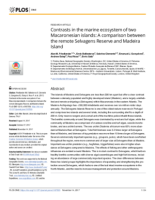Contrasts in the marine ecosystem of two Macaronesian islands: A comparison between the remote Selvagens Reserve and Madeira Island

The islands of Madeira and Selvagens are less than 300 km apart but offer a clear contrast between a densely populated and highly developed island (Madeira), and a largely uninhabited and remote archipelago (Selvagens) within Macaronesia in the eastern Atlantic. The Madeira Archipelago has ~260,000 inhabitants and receives over six million visitor days annually. The Selvagens Islands Reserve is one of the oldest nature reserves in Portugal and comprises two islands and several islets, including the surrounding shelf to a depth of 200 m. Only reserve rangers and a small unit of the maritime police inhabit these islands.
The benthic community around Selvagens was dominated by erect and turf algae, while the community at Madeira was comprised of crustose coralline and turf algae, sessile invertebrates, and sea urchin barrens. The sea urchin Diadema africanum was 65% more abundant at Madeira than at Selvagens. Total fish biomass was 3.2 times larger at Selvagens than at Madeira, and biomass of top predators was more than 10 times larger at Selvagens. Several commercially important species (e.g., groupers, jacks), which have been overfished throughout the region, were more common and of larger size at Selvagens than at Madeira. Important sea urchin predators (e.g., hogfishes, triggerfishes) were also in higher abundance at Selvagens compared to Madeira.
The effects of fishing and other anthropogenic influences are evident around Madeira. This is in stark contrast to Selvagens, which harbors healthy benthic communities with diverse algal assemblages and high fish biomass, including an abundance of large commercially important species. The clear differences between these two island groups highlights the importance of expanding and strengthening the protection around Selvagens, which harbors one of the last intact marine ecosystems in the North Atlantic, and the need to increase management and protection around Madeira.







